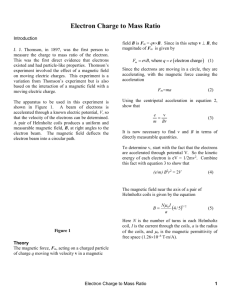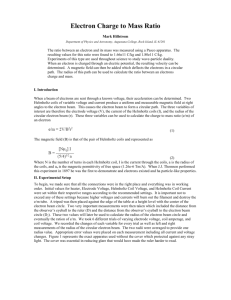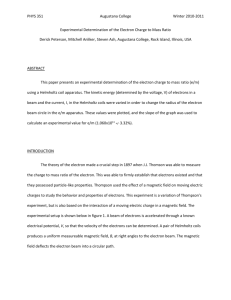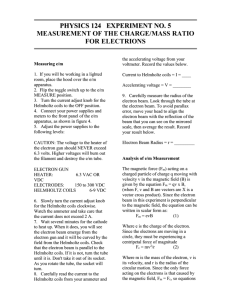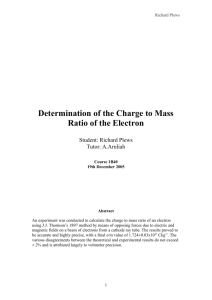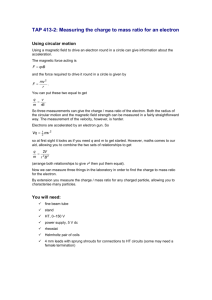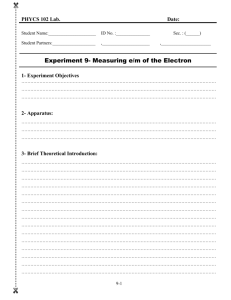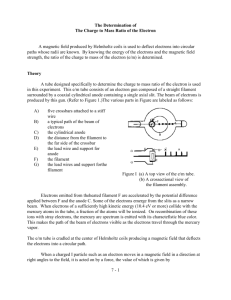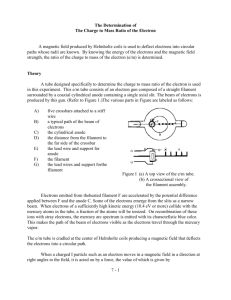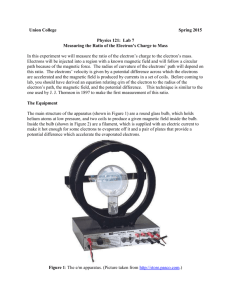Merhi em ratio comments - Helios
advertisement
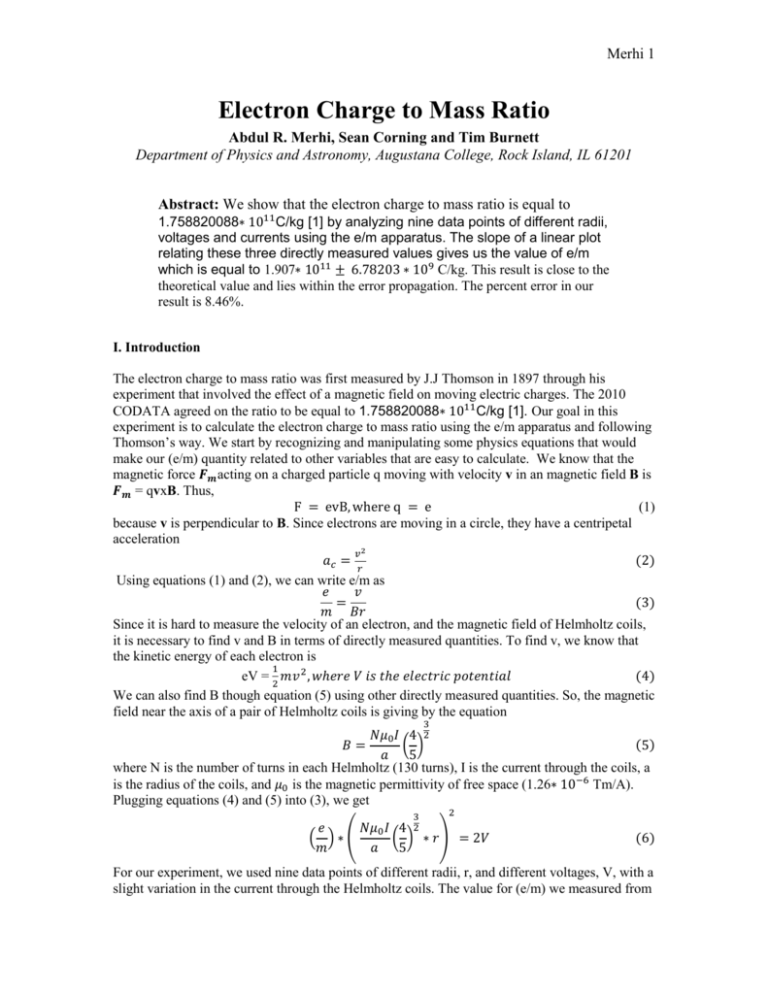
Merhi 1 Electron Charge to Mass Ratio Abdul R. Merhi, Sean Corning and Tim Burnett Department of Physics and Astronomy, Augustana College, Rock Island, IL 61201 Abstract: We show that the electron charge to mass ratio is equal to 1.758820088∗ 1011C/kg [1] by analyzing nine data points of different radii, voltages and currents using the e/m apparatus. The slope of a linear plot relating these three directly measured values gives us the value of e/m which is equal to 1.907∗ 1011 ± 6.78203 ∗ 109 C/kg. This result is close to the theoretical value and lies within the error propagation. The percent error in our result is 8.46%. I. Introduction The electron charge to mass ratio was first measured by J.J Thomson in 1897 through his experiment that involved the effect of a magnetic field on moving electric charges. The 2010 CODATA agreed on the ratio to be equal to 1.758820088∗ 1011C/kg [1]. Our goal in this experiment is to calculate the electron charge to mass ratio using the e/m apparatus and following Thomson’s way. We start by recognizing and manipulating some physics equations that would make our (e/m) quantity related to other variables that are easy to calculate. We know that the magnetic force 𝑭𝒎 acting on a charged particle q moving with velocity v in an magnetic field B is 𝑭𝒎 = qvxB. Thus, F = evB, where q = e (1) because v is perpendicular to B. Since electrons are moving in a circle, they have a centripetal acceleration 𝑣2 𝑎𝑐 = 𝑟 (2) Using equations (1) and (2), we can write e/m as 𝑒 𝑣 = (3) 𝑚 𝐵𝑟 Since it is hard to measure the velocity of an electron, and the magnetic field of Helmholtz coils, it is necessary to find v and B in terms of directly measured quantities. To find v, we know that the kinetic energy of each electron is 1 eV = 2 𝑚𝑣 2 , 𝑤ℎ𝑒𝑟𝑒 𝑉 𝑖𝑠 𝑡ℎ𝑒 𝑒𝑙𝑒𝑐𝑡𝑟𝑖𝑐 𝑝𝑜𝑡𝑒𝑛𝑡𝑖𝑎𝑙 (4) We can also find B though equation (5) using other directly measured quantities. So, the magnetic field near the axis of a pair of Helmholtz coils is giving by the equation 3 𝑁𝜇0 𝐼 4 2 (5) 𝐵= ( ) 𝑎 5 where N is the number of turns in each Helmholtz (130 turns), I is the current through the coils, a is the radius of the coils, and 𝜇0 is the magnetic permittivity of free space (1.26∗ 10−6 Tm/A). Plugging equations (4) and (5) into (3), we get 3 2 𝑒 𝑁𝜇0 𝐼 4 2 ( )∗( ( ) ∗ 𝑟) = 2𝑉 𝑚 𝑎 5 (6) For our experiment, we used nine data points of different radii, r, and different voltages, V, with a slight variation in the current through the Helmholtz coils. The value for (e/m) we measured from Merhi 2 these nine data points is equal to 1.907∗ 1011 ± 6.78203 ∗ 109 C/kg which is close to the (e/m) theoretical value and it lies within the propagated error. The percent error for our result is 8.46%. II. Experimental Setup The experimental setup is shown in Fig. (1). It consists of the e/m apparatus, 3 power supplies and 2 multi-meters to measure the voltage and the current across the Helmholtz coils. Figure 1: The e/m apparatus connected to three power supplies and two multimeters. While doing the experiment, keep within the following range of values: Heater (6.3V), Electrode Voltage (150-300 VDC), Helmholtz Coil Voltage (6-9 VDC), Helmholtz Coil Current (0-2A). The Helmholtz coils are designed so that the distance between the coils is equal to the radius of the coils. Thus, in order to obtain a value for a, measure the horizontal distance between the centers of the coils which we found to be 15 ± 0.15 𝑐𝑚. As for the connections, we cannot connect the Helmholtz Coil Voltage directly to the power supply (accelerating voltage) where we get 6.3V AC. This would lead to various distributions and magnitudes of the magnetic forces on the electron beam leading to unclear circles. In order to avoid this problem, we need the DC power supply and set it between 6-9V, and thus have same magnetic forces acting on the electron (clear circle). If we want to get rid of one of the power supplies, we can get rid of the heater and connect the e/m apparatus directly to the power supply (accelerating voltage) because it is not necessarily for the heater to be DC. After all the connections are done, turn the lights off and start recording the values of electron beam radii from the ruler available behind the electron beam. It is important to point out that in order to see the green circle formed by the electrons and how its radius changes with voltage and current, this experiment is preformed in dark. That is why having a desk lamp next to you would be necessary. Moreover, there will be parallax due to the fact that the electron beam is closer to you than the scale used to measure it. To correct the parallax, we Merhi 3 used geometry. Our eyes will draw an imaginary triangle passing through center of the electron beam and the center of the ruler. Figure 2 illustrates this point. Figure 2: A triangle within a triangle, showing an idea of how to correct for the parallax using equation (7). Now, using fig. 2, we can correct for the parallax by the following formula 𝑎 𝑏 = (7) 𝑑 𝑒 If we know a (the distance from the eye to the electron circle), d (the distance from the eye to the ruler), and e (the reading of the radius from the ruler), we can find b (the actual radius value). However, using your eyes is risky because you need to keep your eyes at the same place from the beginning of taking the measurements until the end, or you will need to measure distance d every time your eyes move (because the parallax changes). Now, all what we need is take our nice data points by recording the radius of the electron beam from the ruler, and the voltage and current across the Helmholtz coils for each point. III. Results In order to determine the value of e/m from the slope of an appropriate graph using our 3 data points, we used equation (6) where the x-axis should be ( 𝑁𝜇0 𝐼 4 2 (5) 𝑎 2 ∗ 𝑟) while the y- axis corresponds to 2V for each data point. Figure 3 shows the result of our data as a linear plot of slope e/m with x and y error bars. Merhi 4 Figure 3: A linear plot showing 2V verses 𝐵2 ∗ 𝑟 2 with (e/m) slope equals to 1.907∗ 1011 𝐶/𝑘𝑔. Thus, the slope of our linear graph which is equal to the experimental value of e/m is 1.907∗ 1011 ± 6.78203 ∗ 109 C/kg. Comparing this value to the theoretical value for e/m which is equal to 1.758820088∗ 1011C/kg [1], we find that our theoretical value is close to the theoretical one and it lies within the value of the propagated error. The percent error calculated to be 8.46%. IV. Discussion Our result shows that our value for e/m is very close to the theoretical value. We had a percent error of 8.46% which is acceptable since our value lies within the propagated error value. However, a number of factors played a role in making our experimental value do not perfectly match with the theoretical one. One factor is reading of the radius of the electrons circle which was fading as we move to the left. Due to Helium atoms, electrons slowed down and thus moved in concentric circles of smaller diameter than our desired circle that we need to take measurements for. This makes taking the measurements harder and less accurate. Also keeping the eye fixed in its place is a very hard thing to maintain which might slightly mess up the results of the experiment. Besides, I would like to mention that the range of the radii that our data points are limited for is very small which makes it harder for us to keep the proportionality of the voltage change and the radius change accurate throughout. For example, we might go from 290V to 20V and only notice the radius decreased by 0.1cm. Merhi 5 As a conclusion, the error values in every data measurement we took allowed us to propagate the error, and thus find a value for e/m lies within the theoretical value when considering its error propagation. References [1] Mass-to-charge ratio Wikipedia. “http://en.wikipedia.org/wiki/Mass-tocharge_ratio”. [2] Electron Charge to Mass Ratio lab manual. Appendix The following pictures are the added information and calculations to the lab notebook after the last submission: Merhi 6 The following figures show the excel sheet of all the calculations we did to reach our result: Merhi 7
